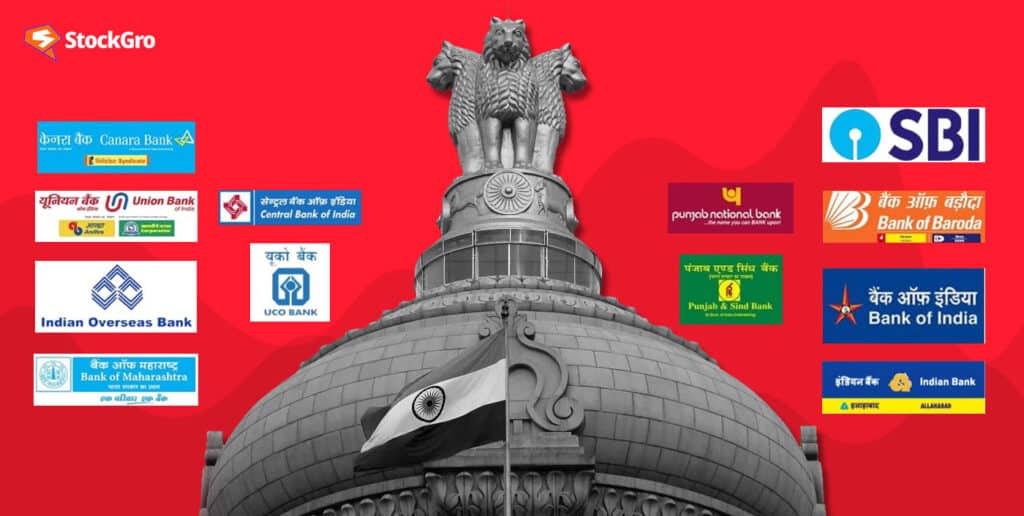
Public Sector Undertakings (PSUs) banks play a crucial role in India’s extensive financial system. As state-owned financial institutions, these institutions are vital to India’s economy. More than just a source of basic banking services, they contribute significantly to the expansion and stability of the national economy. Buying PSU ETFs is a great way to invest in government-owned banks that cater to a very large customer base.
PSU banks in India serve purposes that go far beyond those of conventional financial institutions. Particularly in outlying and rural regions, where private sector banks have limited presence, they are essential in carrying out government policies at the local level.
This article will explore the world of PSU banks, their history, key figures, and their influence on India’s economic development in the sections that follow. Keep watching for a fascinating exploration of India’s public sector banks.
History of public sector banks in India
Public Sector Banks (PSBs) in India have a rich history that reflects the country’s economic transformation. When the Banks of Calcutta, Bombay, and Madras were established in 1806, this journey began.
An important turning point in India’s banking history came in 1921 when these three banks merged to establish the Imperial Bank of India. The original bank rebranded itself as the State Bank of India (SBI) in 1955.
The Indian government nationalised 14 large banks in 1969 and six more in 1980 as part of a larger plan to increase financial inclusion and increase government oversight of the banking industry. Banking services were brought to the doorstep of the common man and integrated into the economic mainstream by this decision, marking a new era in India’s banking sector.
Public sector banks (PSBs) have long been an integral part of India’s economy, helping to propel expansion and bolster vital areas like farming and small business. They have been instrumental in India’s economic and social growth by serving customers in both urban and rural areas.
Beyond influencing the economic fate of millions of Indians, their influence goes far beyond simple financial transactions. With such a long history, PSBs in India have proven to be an integral part of the country’s economy, and their function has only grown over the years to meet the demands of the people and the economy. Want to know what banking and PSU mutual funds are? They are open-ended mutual funds that invest a large portion of their cash in debt instruments issued by PSUs, banks, and other financial institutions.
Major public sector banks in India
The nation’s economy relies on public sector banks (PSBs) to provide millions of people with the banking services they need. Now the question arises, how many PSU banks are in India? There are currently 12 prominent PSBs operating in India. Among them are:
| Sr. No. | Name of the bank |
| 1. | Bank of Baroda |
| 2. | Bank of India |
| 3. | Bank of Maharashtra |
| 4. | Canara Bank |
| 5. | Central Bank of India |
| 6. | Indian Bank |
| 7. | Indian Overseas Bank |
| 8. | Punjab & Sind Bank |
| 9. | Punjab National Bank |
| 10. | State Bank of India |
| 11. | UCO Bank |
| 12. | Union Bank of India |
Also read: The best banks in India: Leading the way in finance
Now, let’s talk about some of the top PSU banks in India in detail:
State Bank of India (SBI): For over 20 years, SBI has served as India’s premier public sector bank. With over 65,627 automated teller machines (ATMs), 22,405 branches, and 76,089 BC outlets, they serve over 48 crore customers. As the Indian economy begins to recover, SBI aims to become the go-to bank for customers by offering innovative, speedy, and easy banking solutions.
Punjab National Bank (PNB): The first Swadeshi Bank in India, PNB, was founded in Lahore on April 12, 1895. With over 12,455 ATMs and over 10,108 branches, PNB is now the second-largest PSB in India, thanks to its merger with the United Bank of India and Oriental Bank of Commerce.
Canara Bank: There are 9,585 branches and 12,120 ATMs at Canara Bank now that it merged with Syndicate Bank. It has been around since 1906 and has a business size of more than ₹16 trillion, making it one of the oldest banks in the country.
Union Bank of India: Now that Andhra Bank and Corporation Bank have merged, Union Bank of India has 8,450 branches and over 76,300 automated teller machines. Robust banking solutions and a focus on customers have made it famous.
Also read: Union Bank of India raises ₹3,000 crore through QIP, stock price soars 7%
Challenges faced by public sector banks
Despite their crucial role in the Indian economy, public sector banks (PSBs) encounter various obstacles:
Non-performing assets (NPAs): With high levels of non-performing assets (NPAs), public sector banks face serious risks. Both the profitability and the ability to lend have been affected by the ongoing problem of bad loans at these banks.
Operational inefficiencies: Operational inefficiencies are a common problem for PSBs, and they have the potential to damage their ability to compete and provide good customer service.
Technological upgradation: It is becoming more difficult for PSBs to keep up with the changing demands of their customers as a result of the fast development of technology.
Competition: Competition has heated up thanks to the growth of private sector banks and fintech firms, compelling PSBs to upgrade their services and introduce innovations.
Regulatory environment: PSBs frequently find themselves constrained in their ability to adapt and respond due to the stringent regulations in which they operate.
Also read: NPA: The tipping point in banking and economy
Recent reforms and future outlook
To fortify the Public Sector Banks (PSBs), the Indian government has implemented several substantial reforms. These include
Consolidation of banks: To make the banking system more streamlined and robust, the government has merged numerous PSBs. A handful of examples include the mergers and acquisitions of major Indian banks such as Union Bank of India, Canara Bank, Punjab National Bank, Indian Bank, United Bank of India and Oriental Bank of Commerce.
Recapitalisation: To boost their capital adequacy ratios and increase their lending capacity, the government has injected capital into the PSBs.
Improvements in governance and management: To give PSBs greater independence and efficiency, the government is concentrating on reforming their governance.
Measures to reduce non-performing assets (NPAs): To hasten the resolution of troubled assets, the government has enacted the Insolvency and Bankruptcy Code (IBC).
Technological upgradation: To bring their services and operations up to date, PSBs have begun to pour a lot of money into technologies like AI, blockchain, and robotic process automation.
PSU banks in India’s share price
To measure the efficiency of government-owned financial institutions trading on the NSE, analysts created the Nifty PSU Bank Index.
The current trading price of the Nifty PSU Bank Index is 7,076.05 points as of February 23, 2024. With a gain of 41.69% in the most recent quarter and 93.88% year-to-date, the index is riding high. When looking at the stock market performance of PSU banks as a whole, this index is a solid indication.
Factors such as the market’s mood, economic circumstances, and the bank’s financial performance all have an impact on the share prices of PSU banks.
Take a few of the best PSU bank stocks in India, State Bank of India (SBI) for example; as of February 23, 2024, its share price is ₹759.05; Punjab National Bank (PNB) is ₹127.95; Bank of Baroda is ₹268.85; Canara Bank is ₹580.45, and Union Bank of India is ₹145.90. These prices provide a solid indication of the current market position of these banks.
Bottomline
Public Sector Banks (PSBs) in India have proven time and again that they can persevere and change with the times. The role they play in India’s economic development remains crucial, despite the challenges. The recent reforms and the increasing adoption of digital technologies have opened new avenues for these banks. Explore the benefits of investing in PSU funds, including stability, dividend income, and growth potential. Government backing and professional management make them an attractive investment option.
As we navigate through the complexities of the financial world, the story of PSBs serves as a reminder of the power of perseverance, adaptation, and reform.

